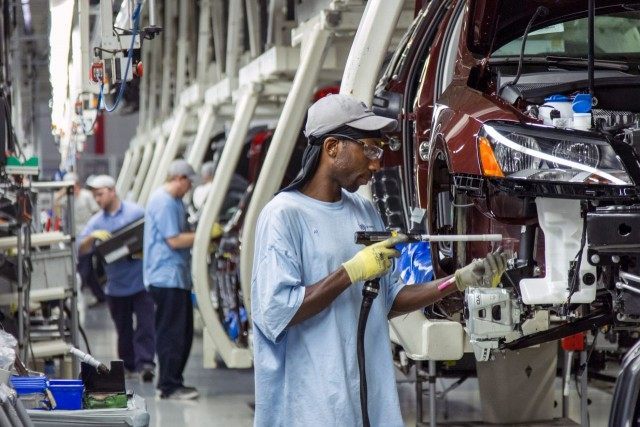Monday’s Chicago Purchasing Manager’s Index for Mid-West manufacturing plunge to a score of 48.7 would have caused widespread economic concern three decades ago, but today’s blue-collar employment is down to only one in twelve Americans.
The PMI was once a very closely followed measure of manufacturing and related activities, in the days when the U.S. was the largest manufacturer in the world. A score above 50 signaled expansions and hiring; while a score below 50 signaled meant layoffs ahead.
But since the 1990s, only about half of the blue-collar employment remains that once generated “good jobs at good wages” to push Americans into the middle class.
For November, Bloomberg reported that economists had estimated that the blue-color barometer for the upper Mid-west would dip slightly in November to a score of 54, from 56.2 in October. But factory orders surprisingly fell to their lowest level in six months, pushing the average reading to a slight negative for the year.
The PMI report would have tanked the stock market two decades ago, but traders shock off the grim report and the market indexes broke even for the day.
The Chicago PMI survey focuses on local economic health of the upper Mid-West, but there are 5 other regions followed by the Federal Reserve Districts that publish manufacturing data in the Beige Book each month. Combining the PMI report with the Fed reports, indicator suggest that manufacturing has been flat, despite monthly ups and downs, since 2014.
Weak manufacturing is being blamed on the strength of the U.S. dollar. The greenback recently appreciated to its strongest level since April versus the euro, and its highest level in two months versus the yen, after a Labor Department report showed U.S. employers added 271,000 jobs in October, the strongest job growth this year.
Despite the weak Chicago PMI report for manufacturing, there are currently 1,249 million jobs advertised as available in the Mid-West. That indicates substantial strength in the services sector, whichtis 78 percent of the region’s economy.
China had rightly been blamed as a major culprit for currency manipulation in order to make its exports cheaper. But with about a third of all Chinese domestic loans now priced in U.S. dollars, the national government must be careful because a major devaluation could lead to a massive number of domestic bankruptcies and huge job losses.
That explains why China agreed to follow the rules necessary to join the International Monetary Fund as a “reserve currency” this week. As a member of the group of advanced economies that set the benchmark price of a “currency basket”–including the U.S. dollar, euro, British pound and Japanese yen–China will gain tremendous prestige. But it will also have to start playing by enforceable rules on terms of trade.
Although approved today, the yuan will not officially become a reserve currency until September 2016.

COMMENTS
Please let us know if you're having issues with commenting.